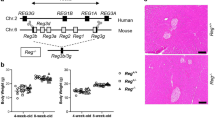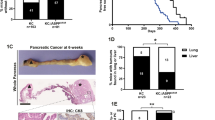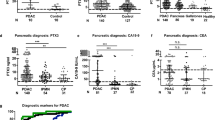Abstract
Late diagnosis and ineffective therapeutic options mean that pancreatic ductal adenocarcinoma (PDA) is one of the most lethal forms of human cancer. The identification of genetic alterations facilitated the launch of the Pancreatic Intraepithelial Neoplasm nomenclature, a standardized classification system for pancreatic duct lesions, but the factors that contribute to the development of such lesions and their progression to high-grade neoplasia remain obscure. Age, smoking, obesity and diabetes confer increased risk of PDA, and the presence of chronic pancreatitis is a consistent risk factor for pancreatic cancer. It is hypothesized that chronic inflammation generates a microenvironment that contributes to malignant transformation in the pancreas, as is known to occur in other organs. Pancreatic stellate cells (PSCs) are the main mediator of fibrogenesis during chronic pancreatitis, but their contribution to the development of PDA has not been elucidated. Data now suggest that PSCs might assume a linking role in inflammation-associated carcinogenesis through their ability to communicate with inflammatory cells, acinar cells, and pancreatic cancer cells in a complicated network of interactions. In this Review, the role of PSCs in the process of inflammation-associated carcinogenesis is discussed and new potential treatment options evaluated.
Key Points
-
The pancreatic stellate cell (PSC) is a recently identified cell population in the pancreas
-
The PSC's ability to produce extracellular matrix proteins, growth factors, cytokines and chemokines means that it has an important role in chronic inflammatory processes of the pancreas
-
Although the role of PSCs in chronic pancreatitis has been defined over the past 5 years, the role of PSCs in pancreatic cancer is not yet understood
-
Data now indicate that PSCs have a crucial role in inflammation-associated cancer of the pancreas; analyzing the role of PSCs in pancreatic cancer might, therefore, broaden the horizon of understanding PDA and open up new therapeutic or diagnostic options
This is a preview of subscription content, access via your institution
Access options
Subscribe to this journal
Receive 12 print issues and online access
$209.00 per year
only $17.42 per issue
Buy this article
- Purchase on SpringerLink
- Instant access to full article PDF
Prices may be subject to local taxes which are calculated during checkout


Similar content being viewed by others
References
Lowenfels AB and Maisonneuve P (2004) Epidemiology and prevention of pancreatic cancer. Jpn J Clin Oncol 34: 238–244
Jemal A et al. (2005) Cancer statistics 2005. CA Cancer J Clin 55: 10–30
Allison DC et al. (1998) DNA content and other factors associated with ten-year survival after resection of pancreatic carcinoma. J Surg Oncol 67: 151–159
Hruban RH et al. (2000) Genetic progression in the pancreatic ducts. Am J Pathol 156: 1821–1825
Burris HA 3rd et al. (1997) Improvements in survival and clinical benefit with gemcitabine as first-line therapy for patients with advanced pancreas cancer: a randomized trial. J Clin Oncol 15: 2403–2413
Moore MJ et al. (2007) Erlotinib plus gemcitabine compared with gemcitabine alone in patients with advanced pancreatic cancer: a phase III trial of the National Cancer Institute of Canada Clinical Trials Group. J Clin Oncol 25: 1960–1966
Cunningham D et al. (2005) Phase III randomised comparison of gemcitabine (GEM) versus gemcitabine plus capecitabine (GEM-CAP) in patients with advanced pancreatic cancer [abstract]. Eur J Cancer 3 (Suppl): 12
Yeo TP et al. (2002) Pancreatic cancer. Curr Probl Cancer 26: 176–275
Hruban RH et al. (2006) Pancreatic cancer in mice and man: the Penn Workshop 2004. Cancer Res 66: 14–17
Almoguera C et al. (1988) Most human carcinomas of the exocrine pancreas contain mutant c-K-ras genes. Cell 53: 549–554
Hruban RH et al. (1993) K-ras oncogene activation in adenocarcinoma of the human pancreas. A study of 82 carcinomas using a combination of mutant-enriched polymerase chain reaction analysis and allele-specific oligonucleotide hybridization. Am J Pathol 143: 545–554
Hingorani SR et al. (2003) Preinvasive and invasive ductal pancreatic cancer and its early detection in the mouse. Cancer Cell 4: 437–450
Hruban RH et al. (2006) Pathology of genetically engineered mouse models of pancreatic exocrine cancer: consensus report and recommendations. Cancer Res 66: 95–106
Lowenfels AB et al. (1993) Pancreatitis and the risk of pancreatic cancer. International Pancreatitis Study Group. N Engl J Med 328: 1433–1437
Malka D et al. (2002) Risk of pancreatic adenocarcinoma in chronic pancreatitis. Gut 51: 849–852
Whitcomb DC and Pogue-Geile K (2002) Pancreatitis as a risk for pancreatic cancer. Gastroenterol Clin North Am 31: 663–678
Virchow R (1863–1865) Die krankhaften Geschwülste, edn 1 (3 vols). Berlin: August Hirschwald
Karin M and Greten FR (2005) NF-kappaB: linking inflammation and immunity to cancer development and progression. Nat Rev Immunol 5: 749–759
Itzkowitz SH and Yio X (2004) Inflammation and cancer IV. Colorectal cancer in inflammatory bowel disease: the role of inflammation. Am J Physiol Gastrointest Liver Physiol 287: G7–G17
Moody GA et al. (1996) Long-term therapy with sulphasalazine protects against colorectal cancer in ulcerative colitis: a retrospective study of colorectal cancer risk and compliance with treatment in Leicestershire. Eur J Gastroenterol Hepatol 8: 1179–1183
Coussens LM and Werb Z (2002) Inflammation and cancer. Nature 420: 860–867
Macarthur M et al. (2004) Inflammation and Cancer II. Role of chronic inflammation and cytokine gene polymorphisms in the pathogenesis of gastrointestinal malignancy. Am J Physiol Gastrointest Liver Physiol 286: G515–G520
Whitcomb DC (2004) Inflammation and Cancer V. Chronic pancreatitis and pancreatic cancer. Am J Physiol Gastrointest Liver Physiol 287: G315–G319
Lowenfels AB et al. (1997) Hereditary pancreatitis and the risk of pancreatic cancer. International Hereditary Pancreatitis Study Group. J Natl Cancer Inst 89: 442–446
Howes N et al. (2004) Clinical and genetic characteristics of hereditary pancreatitis in Europe. Clin Gastroenterol Hepatol 2: 252–261
Logsdon CD et al. (2003) Molecular profiling of pancreatic adenocarcinoma and chronic pancreatitis identifies multiple genes differentially regulated in pancreatic cancer. Cancer Res 63: 2649–2657
Whitcomb DC et al. (1996) Hereditary pancreatitis is caused by a mutation in the cationic trypsinogen gene. Nat Genet 14: 141–145
Witt H et al. (2000) Mutations in the gene encoding the serine protease inhibitor, Kazal type 1 are associated with chronic pancreatitis. Nat Genet 25: 213–216
Witt H (2003) Chronic pancreatitis and cystic fibrosis. Gut 52 (Suppl 2): ii31–ii41
Etemad B and Whitcomb DC (2001) Chronic pancreatitis: diagnosis, classification, and new genetic developments. Gastroenterology 120: 682–707
Kloppel et al. (2004) Fibrosis of the pancreas: the initial tissue damage and the resulting pattern. Virchows Arch 445: 1–8
Apte MV et al. (1998) Periacinar stellate shaped cells in rat pancreas: identification, isolation, and culture. Gut 43: 128–133
Bachem MG et al. (1998) Identification, culture, and characterization of pancreatic stellate cells in rats and humans. Gastroenterology 115: 421–432
Schmid-Kotsas A et al. (1999) Lipopolysaccharide-activated macrophages stimulate the synthesis of collagen type I and C-fibronectin in cultured pancreatic stellate cells. Am J Pathol 155: 1749–1758
Luttenberger T et al. (2000) Platelet-derived growth factors stimulate proliferation and extracellular matrix synthesis of pancreatic stellate cells: implications in pathogenesis of pancreas fibrosis. Lab Invest 80: 47–55
Schneider E et al. (2001) Identification of mediators stimulating proliferation and matrix synthesis of rat pancreatic stellate cells. Am J Physiol Cell Physiol 281: C532–C543
Mews P et al. (2002) Pancreatic stellate cells respond to inflammatory cytokines: potential role in chronic pancreatitis. Gut 50: 535–541
Apte MV et al. (1999) Pancreatic stellate cells are activated by proinflammatory cytokines: implications for pancreatic fibrogenesis. Gut 44: 534–541
Yokota T et al. (2002) Pancreatic stellate cell activation and MMP production in experimental pancreatic fibrosis. J Surg Res 104: 106–111
Apte MV and Wilson JS (2003) Stellate cell activation in alcoholic pancreatitis. Pancreas 27: 316–320
Phillips PA et al. (2003) Cell migration: a novel aspect of pancreatic stellate cell biology. Gut 52: 677–682
McCarroll JA et al. (2004) Pancreatic stellate cell migration: role of the phosphatidylinositol 3-kinase (PI3-kinase) pathway. Biochem Pharmacol 67: 1215–1225
Masamune A et al. (2005) Endothelin-1 stimulates contraction and migration of rat pancreatic stellate cells. World J Gastroenterol 11: 6144–6151
Shek FW et al. (2002) Expression of transforming growth factor-beta 1 by pancreatic stellate cells and its implications for matrix secretion and turnover in chronic pancreatitis. Am J Pathol 160: 1787–1798
Gao R and Brigstock DR (2005) Connective tissue growth factor (CCN2) in rat pancreatic stellate cell function: integrin alpha5beta1 as a novel CCN2 receptor. Gastroenterology 129: 1019–1030
Vogelmann R et al. (2001) Effects of fibrogenic mediators on the development of pancreatic fibrosis in a TGF-beta1 transgenic mouse model. Am J Physiol Gastrointest Liver Physiol 280: G164–G172
Jaster R et al. (2002) Extracellular signal regulated kinases are key mediators of mitogenic signals in rat pancreatic stellate cells. Gut 51: 579–584
Ohnishi N et al. (2003) Activin A is an autocrine activator of rat pancreatic stellate cells: potential therapeutic role of follistatin for pancreatic fibrosis. Gut 52: 1487–1493
Klonowski-Stumpe H et al. (2003) Production and effects of endothelin-1 in rat pancreatic stellate cells. Pancreas 27: 67–74
Masamune A et al. (2002) Activated rat pancreatic stellate cells express intercellular adhesion molecule-1 (ICAM-1) in vitro. Pancreas 25: 78–85
Apte MV et al. (2004) Desmoplastic reaction in pancreatic cancer: role of pancreatic stellate cells. Pancreas 29: 179–187
Cubilla AL and Fitzgerald PJ (1976) Morphological lesions associated with human primary invasive nonendocrine pancreas cancer. Cancer Res 36: 2690–2698
Bachem MG et al. (2005) Pancreatic carcinoma cells induce fibrosis by stimulating proliferation and matrix synthesis of stellate cells. Gastroenterology 128: 907–921
Joshi SV et al. (2006) Pancreatic stellate cells stimulate pancreatic cancer growth and metastasis: Findings of a novel orthotopic model of pancreatic cancer. Pancreas 33: 472–473
Hartel M et al. (2004) Desmoplastic reaction influences pancreatic cancer growth behavior. World J Surg 28: 818–825
Dornhofer N et al. (2006) Connective tissue growth factor-specific monoclonal antibody therapy inhibits pancreatic tumor growth and metastasis. Cancer Res 66: 5816–5827
Aikawa T et al. (2006) Connective tissue growth factor-specific antibody attenuates tumor growth, metastasis, and angiogenesis in an orthotopic mouse model of pancreatic cancer. Mol Cancer Ther 5: 1108–1116
Hezel AF et al. (2006) Genetics and biology of pancreatic ductal adenocarcinoma. Genes Dev 20: 1218–1249
Wagner M et al. (1998) Malignant transformation of duct-like cells originating from acini in transforming growth factor transgenic mice. Gastroenterology 115: 1254–1262
Armstrong T et al. (2004) Type I collagen promotes the malignant phenotype of pancreatic ductal adenocarcinoma. Clin Cancer Res 10: 7427–7437
Esposito I et al. (2006) Tenascin C and annexin II expression in the process of pancreatic carcinogenesis. J Pathol 208: 673–685
Koninger J et al. (2004) Overexpressed decorin in pancreatic cancer: potential tumor growth inhibition and attenuation of chemotherapeutic action. Clin Cancer Res 10: 4776–4783
Koninger J et al. (2004) Pancreatic tumor cells influence the composition of the extracellular matrix. Biochem Biophys Res Commun 322: 943–949
Phillips PA et al. (2003) Rat pancreatic stellate cells secrete matrix metalloproteinases: implications for extracellular matrix turnover. Gut 52: 275–282
Crawford HC et al. (2002) Matrix metalloproteinase-7 is expressed by pancreatic cancer precursors and regulates acinar-to-ductal metaplasia in exocrine pancreas. J Clin Invest 109: 1437–1444
Garcea G et al. (2005) Molecular prognostic markers in pancreatic cancer: a systematic review. Eur J Cancer 41: 2213–2236
Masamune A et al. (2006) Galectin-1 induces chemokine production and proliferation in pancreatic stellate cells. Am J Physiol Gastrointest Liver Physiol 290: G729–G736
Bramhall SR (2000) Novel non-operative treatment and treatment strategies in pancreatic cancer. Expert Opin Investig Drugs 9: 1179–1195
Jaster R et al. (2003) Inhibition of pancreatic stellate cell activation by the hydroxymethylglutaryl coenzyme A reductase inhibitor lovastatin. Biochem Pharmacol 65: 1295–1303
Masamune A et al. (2002) Ligands of peroxisome proliferator-activated receptor-gamma induce apoptosis in AR42J cells. Pancreas 24: 130–138
van Westerloo DJ et al. (2005) Therapeutic effects of troglitazone in experimental chronic pancreatitis in mice. Am J Pathol 166: 721–728
Bachem MG et al. (2006) Role of stellate cells in pancreatic fibrogenesis associated with acute and chronic pancreatitis. J Gastroenterol Hepatol 21 (Suppl 3): S92–S96
Author information
Authors and Affiliations
Corresponding author
Ethics declarations
Competing interests
The authors declare no competing financial interests.
Rights and permissions
About this article
Cite this article
Algül, H., Treiber, M., Lesina, M. et al. Mechanisms of Disease: chronic inflammation and cancer in the pancreas—a potential role for pancreatic stellate cells?. Nat Rev Gastroenterol Hepatol 4, 454–462 (2007). https://doi.org/10.1038/ncpgasthep0881
Received:
Accepted:
Issue Date:
DOI: https://doi.org/10.1038/ncpgasthep0881



